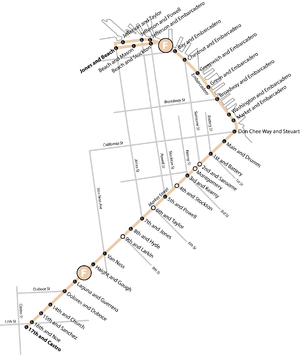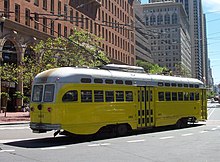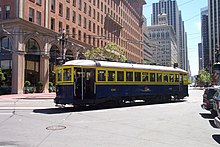F Market & Wharves
| F Market & Wharves | |||||||||||||||||||||||||||||||||||||||||||||||||||||||||||||||||||||||||||||||||||||||||||||||||||||||||||||||||||||||||||||||||||||||||||||||||||||||||
|---|---|---|---|---|---|---|---|---|---|---|---|---|---|---|---|---|---|---|---|---|---|---|---|---|---|---|---|---|---|---|---|---|---|---|---|---|---|---|---|---|---|---|---|---|---|---|---|---|---|---|---|---|---|---|---|---|---|---|---|---|---|---|---|---|---|---|---|---|---|---|---|---|---|---|---|---|---|---|---|---|---|---|---|---|---|---|---|---|---|---|---|---|---|---|---|---|---|---|---|---|---|---|---|---|---|---|---|---|---|---|---|---|---|---|---|---|---|---|---|---|---|---|---|---|---|---|---|---|---|---|---|---|---|---|---|---|---|---|---|---|---|---|---|---|---|---|---|---|---|---|---|---|---|
|
Historic tram on the Embarcadero
| |||||||||||||||||||||||||||||||||||||||||||||||||||||||||||||||||||||||||||||||||||||||||||||||||||||||||||||||||||||||||||||||||||||||||||||||||||||||||
|
Course of the F Market & Wharves
| |||||||||||||||||||||||||||||||||||||||||||||||||||||||||||||||||||||||||||||||||||||||||||||||||||||||||||||||||||||||||||||||||||||||||||||||||||||||||
| Gauge : | 1435 mm ( standard gauge ) | ||||||||||||||||||||||||||||||||||||||||||||||||||||||||||||||||||||||||||||||||||||||||||||||||||||||||||||||||||||||||||||||||||||||||||||||||||||||||
| Power system : | 600 V = | ||||||||||||||||||||||||||||||||||||||||||||||||||||||||||||||||||||||||||||||||||||||||||||||||||||||||||||||||||||||||||||||||||||||||||||||||||||||||
| Dual track : | Yes | ||||||||||||||||||||||||||||||||||||||||||||||||||||||||||||||||||||||||||||||||||||||||||||||||||||||||||||||||||||||||||||||||||||||||||||||||||||||||
|
|||||||||||||||||||||||||||||||||||||||||||||||||||||||||||||||||||||||||||||||||||||||||||||||||||||||||||||||||||||||||||||||||||||||||||||||||||||||||
F Market & Wharves is a streetcar line in San Francisco . Its specialty is that only historical railcars are used, most of them built before 1960. In addition to historical tram cars from San Francisco itself, there are also some cars that were originally used in other cities around the world.
The San Francisco Municipal Railway (Muni) is responsible for the operation of the line , supported by the volunteers of the Market Street Railway organization (which has nothing to do with the historic tram company of the same name).
Despite its special character with museum carriages, the F Market & Wharves line is an integral part of the city's public transport network. The carts run about 15 minutes apart for 20 hours a day and transport both locals and tourists along Market Street and the Embarcadero . The same fares are charged on the line as on the other Muni lines. However, because there are not enough trained tram drivers available, some of the courses in rail replacement services have had to be served by buses since 2016 .
history
Former F-line
In 1915, the San Francisco Municipal Railway opened Route F-Stockton . It initially led from the intersection of Laguna / Chestnut Streets in the Marina District via Van Ness Avenue, North Point, Columbus Street and Stockton Street to Market Street . The line was one of the four newly built tram lines for the Panama-Pacific International Exposition . The following year the north end was extended to Scott Street. The south end was extended along 4th Street to the Southern Pacific Station in Townsend in 1947 . In 1951, the tram service on this route was canceled and replaced by trolleybuses , which from then on operated as line 30. The letter "F" became available again and could later be reassigned, albeit for a completely different route.
Former lines on Market Street
The Market Street is a major thoroughfare in San Francisco. Horse-drawn carts originally ran here, but were replaced by a cable tram in 1883 . They were initially operated by the Market Street Railway ( United Railroads of San Francisco from 1902 to 1921 ) and ran along Market Street to the Ferry Building . After the great 1906 San Francisco earthquake, the cable car lines along Market Street were replaced by electric tram lines, as this was now possible - Market Street is practically level. In 1915 the Municipal Railway built its own tram line through Market Street, which now had four tracks from the Ferry Building to Castro. The Muni took over the Market Street Railway in 1944 and reduced the route through Market Street to two tracks.
In 1970, the construction of subway lines began under Market Street. BART and the San Francisco tram lines have been moved underground and the previous cars replaced with new and modern train compositions. However, the tracks along Market Street were left and the cars no longer needed were stored.
Museum railway festivals

When the San Francisco cable cars had to be shut down for two years in 1982 in order to be able to carry out urgently needed renovations, those responsible looked for an alternative tourist attraction. In the following two summers, the old trams were taken from the depot and the Historic Trolley Festival celebrated. The festivals were so successful that they were repeated until 1987. Then the construction of definitive track systems for the new F-Line began.
The new F-Line
After the 1987 festival ended, Muni began replacing the tracks along Market Street with new ones. At the same time, they began to look for a suitable fleet of vehicles for the new line and decided on PCC vehicles that had previously been used in San Francisco. Fourteen additional such cars were then taken over by Philadelphia , in addition to the three own PCC cars that were still operational.
On September 1, 1995, the new line F Market & Wharves was officially opened. In a parade, the cars, now painted in the colors of a number of the American cities in which such trams had once operated, presented themselves to the population. Much higher passenger numbers than expected prompted Muni to buy more historic cars, including eleven Peter Witt cars from Milan in 1998 .
Extension along the Embarcadero
The Embarcadero is Quay Street in northeast San Francisco. It used to be the most important landing point for ships from all over the world and ferries from the places around the San Francisco Bay . But after the large container terminals were relocated to Oakland and the San Francisco - Oakland Bay Bridge made the ferries superfluous, it slowly fell into disrepair. In the 1960s, the Embarcadero Freeway was built over it, which essentially divided the city into two parts here. After the freeway was badly damaged in the Loma Prieta earthquake in 1989, it was decided not to rebuild it.
Instead of traffic, the longer the pleasure occupied the harbor district. Fisherman's Wharf and Pier 39 have become popular tourist destinations and nightlife spots for locals. Therefore, the Embarcadero has now been converted into a wide avenue, with its own lane for the tram. Since March 2000, the F Market & Wharves line has been running to Fisherman's Wharf, two blocks from the north end of the Powel-Hyde cable car line .
E Embarcadero
The E Embarcadero line uses the northeastern part of the F line along The Embarcadero , but instead of turning onto Market Street, it continues along the coast and then south via Folsom and 4th. There were several test runs on this route, for example during the Americas Cup prelims in 2012. A permanent start of operation required the introduction of further bidirectional vehicles, as the south end of this route does not have a turning loop. Regular weekend operations on Line E from Fisherman's Wharf to the Caltrain station on 4th Street finally began on August 1, 2015, and daily operations on April 23, 2016.
Fleet
Muni now has a considerable number of trams that can be used on the F-Line, but they are never all on the move at the same time. The cars usually run individually and not as trains.
The fleet can be divided into four groups: the PCC cars , the Peter Witt cars , pre-PCC cars and cars from all over the world. The main load of the traffic is carried by the PCC and Peter Witt cars, but others are also in regular service.
PCC car
27 PCC cars from SEPTA (Philadelphia) and Newark City Subway are available to Muni, some of which are still being overhauled. 30 more will be ready for use again in the long term.
Many of the restored cars are painted in the colors of a previous or current tram company that uses or used PCC cars. However, the cars all come from San Francisco, Philadelphia or Newark. The companies represented are shown in the following list.
- Baltimore Transit Company
- Birmingham , Alabama
- Boston Elevated Railway
- Brooklyn & Queens Transit Corporation , in New York City
- Chicago Transit Authority
- Cleveland , Ohio
- Cincinnati Street Railway Company
- Detroit , Michigan
- El Paso City Lines , connect El Paso, Texas to Juarez , Mexico
- Illinois Terminal Railroad , in St. Louis, Missouri
- Johnstown Traction Company , in Johnstown, Pennsylvania
- Kansas City Public Service Company , in Kansas City, Missouri
- Los Angeles Railway
- Louisville , Kentucky
- National City Lines
- Newark
- Massachusetts Bay Transportation Authority , in Boston
- Mexico city
- Pacific Electric Railway , in Los Angeles
- Philadelphia Suburban Transportation Company , based in Philadelphia, Pennsylvania
- Philadelphia Transportation Company
- St. Charles Avenue Streetcar , in New Orleans
- San Diego , California
- Toronto Transit Commission
- Twin City Rapid Transit , in Minneapolis-Saint Paul
- Washington, DC
The vehicles that are not yet operational again include five more double-ended PCCs, 10 normal PCCs and 12 cars from St. Louis . Plus two double-end cars from Philadelphia and two normal ones from Pittsburgh . One of the Philadelphia cars had to be written off after an accident.
Peter Witt car
The eleven Peter Witt cars - named after Peter Witt , an American traffic expert - come from the Milan tram in Italy. They belong to the Ventotto series, which originally comprised 502 cars , were built in 1928 and correspond to a type of tram that was also widespread in the United States and is still in use in Milan today.
The car's Italian origin can still be seen today. All passenger information inside the car is still in Italian and has only been supplemented by English.
Pre-PCC Cars (Historic San Francisco Vehicles)
This group of trams includes those that were in service before the introduction of the PCC in San Francisco. One of them is number 578, an open wooden car that looks more like cable cars than other trams. It was built in 1895 for the Market Street Railway Company and is believed to be the oldest car still in active service in the world.
Around the world
There are ten cars from all over the world in this category. They come from the following companies:
- Blackpool tramway , in Blackpool , England
- Hamburger Hochbahn AG , in Hamburg , Germany
- Hankai Electric Rail Service Company , in Osaka , Japan
- Kobe City Railways & Hiroshima Electric Railway , in Kobe & Hiroshima , Japan
- Melbourne & Metropolitan Tramways Board , in Melbourne , Australia
- Moscow , Russia
- STCP , in Porto , Portugal
- STIB / MIVB , in Brussels , Belgium
All of these cars have their original paintwork, except for the one from Brussels, which has the blue and white livery of the Zurich Transport Authority . It was painted this way because Zurich is the sister city of San Francisco. The trams that are actually on the move in Zurich cannot be used in San Francisco, as the Zurich trams use meter gauge.
future plans
There are plans to further extend the F-Line. To the west of the sweeping station on Jones Street is an old, single-track tunnel that is not currently in use and runs under Fort Mason . It is to be put back into operation and lines F or E are to be extended to the west accordingly.
See also
- Trolleybus San Francisco , with which F Market & Wharves shares the trolley line in sections
Web links
- Market Street Railway website
- Transit Rider Photos
- Official route map (PDF file; 167 kB)
Individual evidence
- ↑ Joe Fitzgerald Rodriguez: Historic Muni streetcar shortage highlights driver training woes , September 8, 2016 article in the San Francisco Examiner, online at sfexaminer.com, accessed December 22, 2018
- ↑ Centennial of the (Original) F-line (English) at www.streetcar.org
- ^ Mac Sebree: Kodachrome PCCs Roll Down Market Street . In: Pacific RailNews . November 1995.
- ↑ Peter Ehrlich: PCCs by the Bay . In: Passenger Train Journal . June 1996, p. 24 ff .
- ↑ Ride the E-Line on August 25 and 26 . Muni. Retrieved September 5, 2012.
- ↑ SFMTA: "SFMTA Launches E Embarcadero Historic Streetcar Line" (English)
- ↑ San Francisco streetcar line opening delayed to August 1st . Trains Magazine. July 6, 2015. Accessed July 14, 2015.
- ↑ SFMTA: "Better, More Frequent Service Coming April 23" (English)
- ^ The historic streetcars of the F-line fleet . Market Street Railway. 2012. Retrieved September 5, 2012.
- ^ A b The PCC: A streetcar named success . Market Street Railway. 2007. Archived from the original on February 12, 2008. Retrieved October 14, 2007.
- ↑ The Milan 'Peter Witt' trams . Market Street Railway. 2012. Retrieved September 5, 2012.
- ^ Muni's incomparable antique streetcars . Market Street Railway. 2007. Archived from the original on February 28, 2008. Retrieved October 14, 2007.







